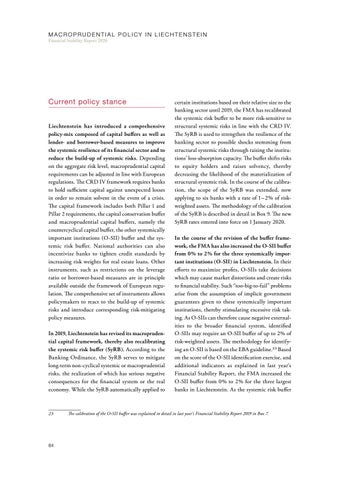M acroprudential policy in L iechtenstein Financial Stability Report 2020
Current policy stance Liechtenstein has introduced a comprehensive policy-m ix composed of capital buffers as well as lender- and borrower-based measures to improve the systemic resilience of its financial sector and to reduce the build-up of systemic risks. Depending on the aggregate risk level, macroprudential capital requirements can be adjusted in line with European regulations. The CRD IV framework requires banks to hold sufficient capital against unexpected losses in order to remain solvent in the event of a crisis. The capital framework includes both Pillar 1 and Pillar 2 requirements, the capital conservation buffer and macroprudential capital buffers, namely the countercyclical capital buffer, the other systemically important institutions ( O -SII ) buffer and the systemic risk buffer. National authorities can also incentivize banks to tighten credit standards by increasing risk weights for real estate loans. Other instruments, such as restrictions on the leverage ratio or borrower-based measures are in principle available outside the framework of European regulation. The comprehensive set of instruments allows policymakers to react to the build-up of systemic risks and introduce corresponding risk-mitigating policy measures. In 2019, Liechtenstein has revised its macroprudential capital framework, thereby also recalibrating the systemic risk buffer ( SyRB ). According to the Banking Ordinance, the SyRB serves to mitigate long-term non-cyclical systemic or macroprudential risks, the realization of which has serious negative consequences for the financial system or the real economy. While the SyRB automatically applied to
certain institutions based on their relative size to the banking sector until 2019, the FMA has recalibrated the systemic risk buffer to be more risk-sensitive to structural systemic risks in line with the CRD IV. The SyRB is used to strengthen the resilience of the banking sector to possible shocks stemming from structural systemic risks through raising the institutions’ loss-absorption capacity. The buffer shifts risks to equity holders and raises solvency, thereby decreasing the likelihood of the materialization of structural systemic risk. In the course of the calibration, the scope of the SyRB was extended, now applying to six banks with a rate of 1 – 2 % of riskweighted assets. The methodology of the calibration of the SyRB is described in detail in Box 9. The new SyRB rates entered into force on 1 January 2020. In the course of the revision of the buffer framework, the FMA has also increased the O-SII buffer from 0 % to 2 % for the three systemically important institutions ( O-SII ) in Liechtenstein. In their efforts to maximize profits, O-SIIs take decisions which may cause market distortions and create risks to financial stability. Such “too-big-to-fail” problems arise from the assumption of implicit government guarantees given to these systemically important institutions, thereby stimulating excessive risk taking. As O-SIIs can therefore cause negative externalities to the broader financial system, identified O-SIIs may require an O-SII buffer of up to 2 % of risk-weighted assets. The methodology for identifying an O-SII is based on the EBA guideline.23 Based on the score of the O-SII identification exercise, and additional indicators as explained in last year’s Financial Stability Report, the FMA increased the O-SII buffer from 0 % to 2 % for the three largest banks in Liechtenstein. As the systemic risk buffer
23 The calibration of the O-SII buffer was explained in detail in last year’s Financial Stability Report 2019 in Box 7.
84

